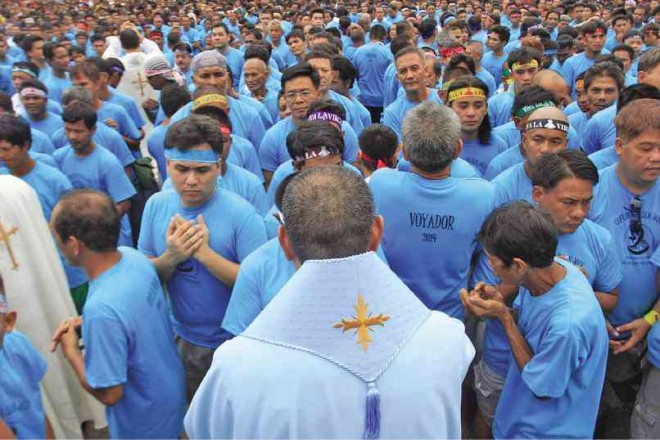
MALE devotees, called “voyadores,” form a line and take the opportunity to kiss the image of Bicol patroness Our Lady of Peñafrancia on Friday, before the traditional “Traslacion” or transfer of the image from Peñafrancia Church to the Naga Metropolitan Cathedral on Friday, signaling the beginning of the weeklong fiesta in Naga City. MARK ALVIC ESPLANA
Should they live up to the “tradition” of “voyadores” to down liquor before lifting the “andas” or carriage of the Our Lady of Peñafrancia or Ina, Bicol’s most revered Catholic icon? Devotees are divided.
The nine-day celebration of the centuries-old Peñafrancia festival in honor of Ina began on Friday with the “Traslacion,” a procession of barefoot men called voyadores, who carried the image of the patroness from the Peñafrancia Shrine to the Naga Metropolitan Cathedral—a distance of three kilometers—in Naga City.
At least half a million devotees joined the procession, according to PO3 Josephus Ramos, a member of the operations staff of the city police.
A liquor ban was imposed in Naga from 6 a.m. on Friday to 7 p.m. when the Traslacion was expected to be over.
Hilario Consulta, 50, did not mind the ban, saying his fellow voyadores should do away with their ways of getting drunk first before rendering service to the Virgin.
Consulta, who hails from Tigaon town, Camarines Sur province, and has been serving as “voyador” for almost 10 years now, said the conduct of the procession should be solemn as a show of respect to the patroness.
Drunkenness disrupts the solemn celebration of the event, he said.
But Jaime Jacob, a former congressman of Camarines Sur who has been attending the event for decades, said the tradition of drunken voyadores must be kept alive to maintain the cultural origin of the practice.
SOLDIERS form an outer human chain surrounding the “voyadores” (male devotees) transporting the image of Nuestra Señora de Peñafrancia during last year’s Traslacion procession, marking the beginning of the weeklong celebrations in Naga City. COURTESY OF 9TH INFANTRY DIVISION PUBLIC AFFAIRS OFFICE/PHILIPPINE ARMY
Most of them do not really go to Church regularly but participate in the procession where they have to “physically struggle to get near the andas of Ina,” he said.
The Philippine National Police has deployed 600 personnel from the provinces of Camarines Sur, Camarines Norte, Albay and Sorsogon to help the 400 city policemen in securing the Peñafrancia fiesta.
Over 600 Army soldiers have also been fielded, according to Lt. Col. Joselito Pastrana, head of the Civil Military Operations Battalion of the 9th Army Infantry Division.
Deoscoro Reyta, 55, who has been joining the procession since he was in college, lamented that the “unruly way of how the early devotees centuries ago did it” could be replaced with the traditional religious activity.
During the liquor ban, anyone showing signs of being intoxicated would be taken into police custody and detained for 12 hours for violating a city ordinance. But so far, no one has been arrested, Ramos said.
For the past years, the Archdiocese of Caceres has come up with some rules to make the procession orderly.
It eliminated the andas made of wood and replaced the platform with a wheeled dome-like metal, one that made it difficult for the voyadores to fling themselves onto the image during the procession.
Because of the change, what used to take the procession four hours to cover the distance from the shrine to the Naga Metropolitan Cathedral was reduced to three.
The archdiocese also assigned uniformed men with combat boots to push the metal platform through several stretches of the procession. But this turned off the voyadores as they were at risk of getting trampled on their bare feet.
Groups of official participants were also given color codes with schedules in bringing Ina to an assigned section in the route.
Lionel Martinez, an American married to a Nagueña, said he joined the Traslacion for the cultural experience as a Catholic even though he is not that religious.
He said he was glad to learn of the procession rules and shared that he was virtually thrown out when he tried to penetrate a group with a designated color.
But Martinez said he was surprised when another group just opened up for him to touch Ina’s metal platform “without struggle,” even though he lost his slippers.
He said he would always “cherish the experience” and found it unbelievable to see “so many people with that kind of devotion.”
The Traslacion coincided with the celebration of the Feast of Divino Rostro (Holy Face of Jesus), an image of which is traditionally part of the procession.
It carried the theme Laity: Sent Forth with Ina to Witness Christ’s Gospel and Strengthen Communities of Faith, said Fr. Rey Jose Rellora, parish priest of Our Lady of Peñafrancia Shrine.
The Traslacion ended around 5:40 p.m. at the Naga Metropolitan Cathedral with a Mass led by Archbishop Rolando Tria Tirona.